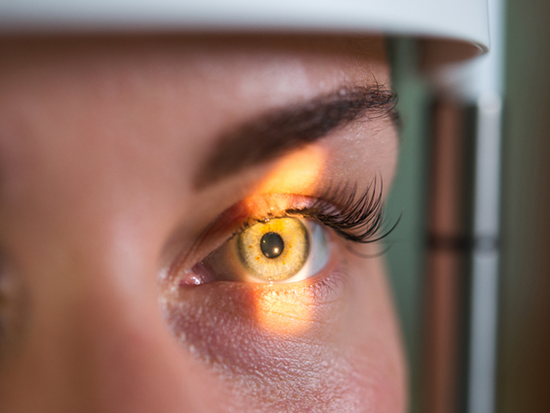News Items
Research evaluates how retina could yield early Alzheimer’s disease diagnosis
Discover how researchers at the University of Alabama at Birmingham are using the retina to diagnose Alzheimer’s disease early. Groundbreaking findings could lead to non-invasive tests, improving treatment outcomes and reducing the burden of the disease.
A groundbreaking study conducted at the University of Alabama at Birmingham School of Optometry is investigating the potential of using the retina as a means to diagnose Alzheimer’s disease in its early stages. The findings of this research could revolutionize the field, leading to non-invasive and cost-effective tests that allow for the early detection of the disease. With Alzheimer’s progressing for decades before symptoms of dementia appear, the ability to diagnose it early on could greatly improve treatment outcomes. By examining changes in the retina, scientists hope to discover new biomarkers that could be used for screening and monitoring the efficacy of interventions. This research has the potential to make a significant impact on both patients and caregivers, reducing the overall burden of Alzheimer’s disease on society.
Research evaluates how retina could yield early Alzheimer’s disease diagnosis

This image is property of www.uab.edu.
Overview
This article discusses ongoing research at the University of Alabama at Birmingham (UAB) that aims to evaluate the role of the retina in diagnosing Alzheimer’s disease. The study focuses on identifying retinal biomarkers that could potentially be used for early detection of the disease. The article highlights the potential impact of early diagnosis and the collaboration between UAB’s Alzheimer’s Disease Research Center and the School of Optometry.
Background
Alzheimer’s disease is a progressive neurodegenerative disease that affects millions of older Americans. As the most common cause of dementia in elderly people, there is a need for effective interventions and treatments. Currently, the disease is diagnosed only when symptoms of dementia emerge, which often happens decades after the disease has progressed. This delay in diagnosis hinders the efficacy of potential treatments. Researchers at UAB are exploring the use of retinal biomarkers to enable early diagnosis of Alzheimer’s disease.
Research Objectives
The objective of the research being conducted at UAB is to identify retinal biomarkers that can serve as indicators of early-stage Alzheimer’s disease. By studying changes in the retina, researchers aim to develop non-invasive and low-cost tests for early detection. The ultimate goal is to offer timely diagnosis and intervention for individuals at risk of developing the disease.
Collaboration with UAB’s Alzheimer’s Disease Research Center
Dr. Edmund Arthur, a vision scientist in the School of Optometry, is collaborating with Dr. Erik Roberson, a neurologist and the director of UAB’s Alzheimer’s Disease Research Center. This collaboration brings together expertise in optometry and neurology to explore the role of the retina in Alzheimer’s disease diagnosis. The UAB Brain Aging and Memory Clinic, led by Dr. Roberson, provides a comprehensive approach to evaluating and treating individuals experiencing cognitive changes associated with aging.
Retinal Biomarkers for Early Diagnosis
The retina offers a unique opportunity for the development of early biomarkers for Alzheimer’s disease. Dr. Arthur aims to incorporate two novel retinal biomarkers, the retinal peripheral capillary free zones and retinal putative gliosis, into a multimodal model for screening early signs of Alzheimer’s disease. These biomarkers, combined with blood-based biomarkers, could provide optometrists with a non-invasive tool for identifying individuals at risk.
Non-Invasive Tests for Early Detection
The research includes a series of non-invasive tests on study participants to assess visual function and retinal imaging. These tests, such as field of vision and contrast sensitivity assessments, along with spectral domain optical coherence tomography (SD-OCT), OCT angiography, and blue autofluorescence imaging, are more accessible and affordable than current evaluation methods. The aim is to develop low-cost screening tools that can be used in Alzheimer’s disease prevention trials and expedite enrollment into treatment programs.
Potential Impact of Early Diagnosis
Early diagnosis of Alzheimer’s disease can have a significant impact on patients, their families, and society as a whole. With an aging population, the demand for clinical services related to cognitive changes is increasing. Early detection allows for timely intervention and treatment, potentially slowing down the progression of the disease and improving quality of life for individuals affected. Furthermore, early diagnosis can reduce the overall burden on healthcare systems, caregivers, and society.
Hot Topic and Research Growth for UABSO
Alzheimer’s disease is currently a prominent topic in the field of research and an area of potential growth for UAB’s School of Optometry (UABSO). By expanding their knowledge and expertise in the early detection of Alzheimer’s disease through retinal biomarkers, UABSO can contribute to advancements in the field. This research presents an opportunity for UABSO to strengthen its position as a leader in eye care and vision science.
Large-Scale Screening and Referral for at-risk individuals
The successful development and implementation of retinal biomarkers for early Alzheimer’s disease detection can lead to large-scale screening programs. Point-of-care clinicians, including optometrists, can use these screening tools to identify individuals at risk and refer them to neurologists and neuropsychologists for further cognitive health assessment. This collaborative approach will enable a comprehensive evaluation and support system for individuals at risk of developing Alzheimer’s disease.
Conclusion
The ongoing research at UAB on the role of the retina in diagnosing Alzheimer’s disease holds great promise for early detection and intervention. By identifying retinal biomarkers, researchers aim to develop non-invasive and cost-effective tests that can be used by optometrists. The potential impact of early diagnosis on individuals, their families, and society makes this research a significant endeavor. With the collaboration between UAB’s School of Optometry and Alzheimer’s Disease Research Center, there is an opportunity for UABSO to contribute to the field and facilitate large-scale screening and referral programs for at-risk individuals.




